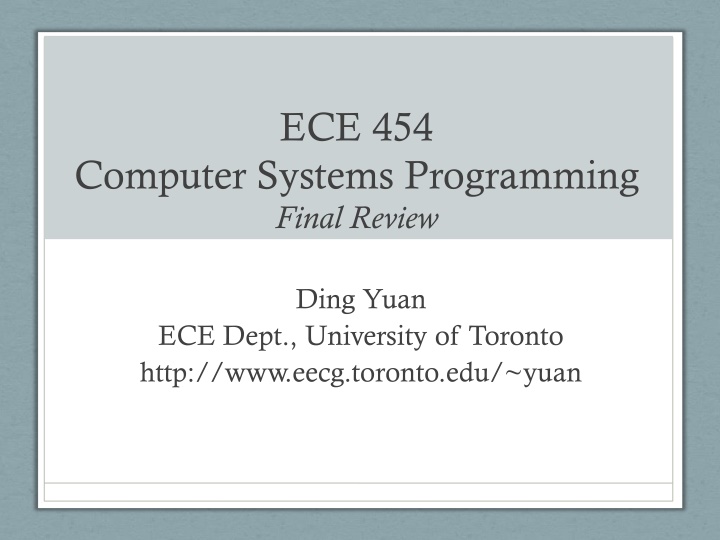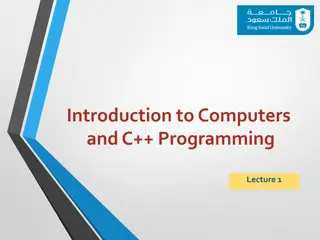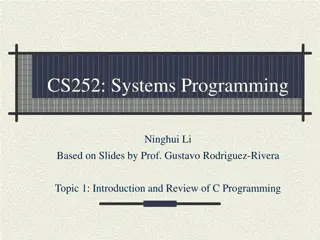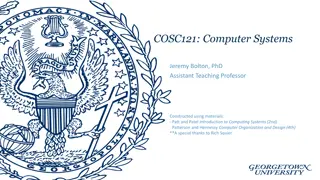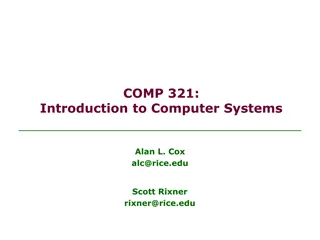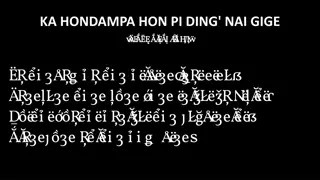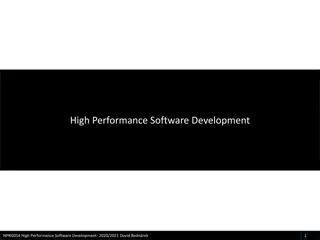ECE454 Computer Systems Programming Final Review by Ding Yuan
The final review for ECE454 Computer Systems Programming by Ding Yuan covers topics such as CPU architecture, compiler optimizations, profiling tools, and parallel programming. The review also includes details on the final exam, office hours, and key concepts discussed in the course.
Uploaded on Feb 24, 2025 | 4 Views
Download Presentation

Please find below an Image/Link to download the presentation.
The content on the website is provided AS IS for your information and personal use only. It may not be sold, licensed, or shared on other websites without obtaining consent from the author.If you encounter any issues during the download, it is possible that the publisher has removed the file from their server.
You are allowed to download the files provided on this website for personal or commercial use, subject to the condition that they are used lawfully. All files are the property of their respective owners.
The content on the website is provided AS IS for your information and personal use only. It may not be sold, licensed, or shared on other websites without obtaining consent from the author.
E N D
Presentation Transcript
ECE 454 Computer Systems Programming Final Review Ding Yuan ECE Dept., University of Toronto http://www.eecg.toronto.edu/~yuan
Announcements Additional office hours Tomorrow 9-12 Final exam Closed book Time: 12/5 9:30 AM Location: EX 100 2 Ding Yuan, ECE454 2025-02-24
Final Mechanics Bulk of the final covers material after midterm Dynamic memory, threads and synchronization, parallel architecture and performance, MapReduce < 30% on material before midterm Expect problems that involve everything we have discussed Based upon lecture material and project 3 2025-02-24 Ding Yuan, ECE454
What we have learnt Sequential program optimization: Parallel programming on single machine: CPU architecture Profiling Compiler optimization Memory hierarchy Cache optimization Dynamic memory Threads Synchronization Parallel architecture and performance Exec. Time P P P C C C P C Ram Ram Parallel programming on distributed system: MapReduce Distributed database Distributed memcache server server server server memory memory memory memory 4 Ding Yuan, ECE454 2025-02-24
CPU architecture Key techniques that make CPU fast Pipeline Branch prediction Out-of-order execution Instruction-level parallelism Simultaneous multithreading Cache coherence What are the implications to software programmer? Why we should always use standard synchronization primitives instead of ad-hoc sync.? 5 Ding Yuan, ECE454 2025-02-24
CPU architecture: Intel Year 1971 Tech. no pipeline Processor 4004 CPI n pipeline close to 1 closer to 1 1985 386 branch prediction Pentium < 1 1993 Superscalar PentiumPro << 1 1995 Out-of-Order exe. Pentium IV 2000 SMT <<<1 6 Ding Yuan, ECE454 2025-02-24
Profiling Tools for profiling gprof gcov unix time perf Rationale behind profiling? Amdahl s law speedup = OldTime / NewTime Implications of Amdahl s law? 7 Ding Yuan, ECE454 2025-02-24
Compiler optimizations Machine independent (apply equally well to most CPUs) Constant propagation Constant folding Common Subexpression Elimination Dead Code Elimination Loop Invariant Code Motion Function Inlining GCC -O1 (only inline very small func.) Machine dependent (apply differently to different CPUs) Instruction Scheduling Loop unrolling GCC O2 GCC O3 Might need to do manually. Trade-offs! 8 Ding Yuan, ECE454 2025-02-24
Role of the Programmer How should I write my programs, given that I have a good, optimizing compiler? Don t: Smash Code into Oblivion Hard to read, maintain, & assure correctness Do: Select best algorithm Write code that s readable & maintainable Procedures, recursion Even though these factors can slow down code Eliminate optimization blockers Allows compiler to do its job Focus on Inner Loops Do detailed optimizations where code will be executed repeatedly Will get most performance gain here 9 Ding Yuan, ECE454 2025-02-24
Cache performance CPU registers hold words retrieved from L1 cache registers Smaller, faster, costlier per byte on-chip L1 cache (SRAM) L1 cache holds cache lines retrieved from L2 cache L2 cache holds cache lines retrieved from main memory on-chip L2 cache (SRAM) Main memory holds disk blocks retrieved from local disks main memory (DRAM) Larger, slower, cheaper per byte local secondary storage (local disks) Local disks hold files retrieved from disks on remote network servers remote secondary storage (tapes, distributed file systems, Web servers) 10 Ding Yuan, ECE454 2025-02-24
Why Caches Work Locality: Programs tend to use data and instructions with addresses near or equal to those they have used recently Temporal locality: Recently referenced items are likely to be referenced again in the near future block Spatial locality: Items with nearby addresses tend to be referenced close together in time block 11 Ding Yuan, ECE454 2025-02-24
Optimize your program for cache performance Write code that has locality Spatial: access data contiguously Temporal: make sure access to the same data is not too far apart in time How to achieve? Proper choice of algorithm Loop transformations Tiling 12 Ding Yuan, ECE454 2025-02-24
Dynamic memory management How do we know how much memory to free just given a pointer? 4 4 6 6 4 4 P1 P2 How do we keep track of the free blocks? Implicit list Explicit list Segregated free list How do we pick a block to use for allocation -- many might fit? How do we reinsert freed block? 13 Ding Yuan, ECE454 2025-02-24
Multithreading What is multithreading? How do we share data across different threads? Communication and synchronization Data race Deadlock How to use pthread libraries to program Coarse-grain lock vs. fine-grain lock 14 Ding Yuan, ECE454 2025-02-24
Example: Parallelize this code a[3] = ; a[4] = ; a[5] = ; for( i=1; i<100; i++ ) { a[i] = ; ; = a[i-1]; } = a[2]; = a[3]; = a[4]; a[4] = ; Problem: each iteration depends on the previous = a[3]; Solution: appropriate synchronization a[5] = ; a[3] = ; = a[4]; = a[2];
Parallel architecture Cores have their private caches P P P P Cache lines might be duplicated (motherboard) C C C C C C Need protocol to communicate Dual-core Dual-core M SMP (Symmetric multiprocessing) 16 Ding Yuan, ECE454 2025-02-24
Cache coherence MESI Modified Exclusive Shared Invalid Why Exclusive is needed? What is false sharing? Why it is bad? Image src.: http://en.wikipedia.org/wiki/MESI_protocol 17 Ding Yuan, ECE454 2025-02-24
Performance implications of parallel architecture Cache coherence is expensive (more than you thought) Avoid unnecessary sharing (e.g., false sharing) Avoid unnecessary coherence (e.g., TAS -> TATAS) Crossing sockets is a killer Can be slower than running the same program on single core! pthread provides CPU affinity mask pin cooperative threads on cores within the same die Loads and stores can be as expensive as atomic operations 18 Ding Yuan, ECE454 2025-02-24
MapReduce Why do we need MapReduce? What is MapReduce? Programming model for big data analytics Programmer writes two functions map (in_key, in_value) -> list(out_key, intermediate_value) Processes input key/value pair Produces set of intermediate pairs reduce (out_key, list(intermediate_value)) -> list(out_key, outvalue) Processes a set of intermediate key-values 19 Ding Yuan, ECE454 2025-02-24
Lessons learnt by facebook KISS Keep it simple, stupid Throw away all the optimizations for locality Simple, scalable data distribution Performance is solved by adding another layer of abstraction --- memcached 20 Ding Yuan, ECE454 2025-02-24
Technology is always changing Sequential program optimization: Parallel programming on single machine: Exec. Time P P P C C C P Moore s law on single core reaches the end -> multicores. C Ram Internet! Ram Parallel programming on distributed system: server server server server memory memory memory memory 21 Ding Yuan, ECE454 2025-02-24
Are what we learnt still useful in 20 years? Why ask me now? Ask me in 2034 Technology is going to change Some techniques might not be relevant Performance might not be very important at all Correctness, easy-to-program, scalability, energy consumption However, key ideas still hold! There is nothing new under the sun Amdahl s law: optimize the bottleneck Cache: CPU cache -> memory cache -> memcached -> CDN Parallelization Avoid unnecessary computation (e.g., unnecessary sharing, sync., etc.) 22 Ding Yuan, ECE454 2025-02-24
More important: critical thinking Why is far more important than how For each technique we learnt, we discussed the why E.g., why cache coherence impact performance? why multi-core? why MapReduce? why Facebook doesn t care about locality? How is just a natural consequence of understanding why The capability of asking the right why question and find out the answer will keep you on top of the technology trend Skepticism + curiosity Do we really need this technology? KISS principle keep it simple, stupid Simple and intuitive ideas often stand the test of time 23 Ding Yuan, ECE454 2025-02-24
The End Congratulations on surviving ECE 454! It s a challenging course, but I hope you found it worthwhile Good luck, and thanks for a great class! You guys were really pushing me hard and asking the challenging questions I really enjoyed it, and I hope the feeling is mutual And if you haven t done so, please submit your course evaluation, thanks! 24 Ding Yuan, ECE454 2025-02-24
